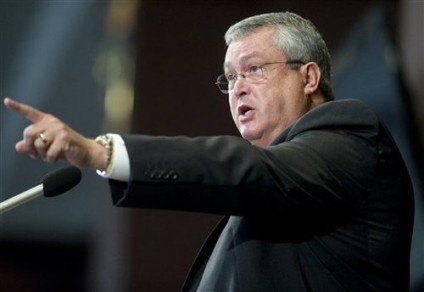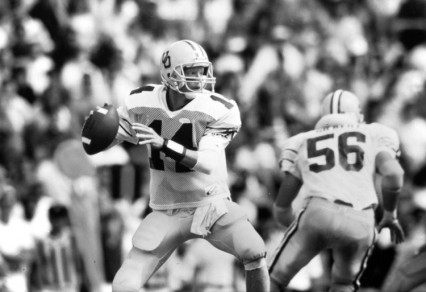Most Duck fans are familiar with the play that changed Oregon football.
Kenny Wheaton’s early break on Washington quarterback Damon Huard’s pass deep in Duck territory and subsequent 97-yard touchdown return propelled the Ducks into the 1995 Rose Bowl and forever improved the program’s trajectory.
The play was spectacular in every way; the break on the ball, the exciting return, and the home crowd cheering him on against a fierce rival.
No one can take away from one of the greatest and most significant plays in Oregon football history.
With that being said, while many see the 1994 season as the launching point for Oregon’s ascension into greatness, an argument could be made for the 1989 season.
After a successful set of seasons, including a trip to the 1958 Rose Bowl against Ohio State and a 1963 Sun Bowl Victory over SMU, the Ducks went through a 26-year bowl draught.
During that time, Oregon’s combined record was a mediocre 101-150.
Despite even the introduction of head coach Rich Brooks to the program in 1977, the Ducks could not seem to find a way to climb out of the bottom of the Pac-10 standings.
The 1989 season changed all that.
For the first time since 1963, the Ducks managed to reach eight wins in a season. Behind the ever-reliable quarterback Bill Musgrave, Oregon football found its way back onto the national map.
The 1989 season was one of the school’s best at the time. The Ducks’ big wins included those over Oregon State in the Civil War and a ranked Arizona team earlier on.
It was only three heartbreaking one-score losses to Washington, BYU, and Stanford that kept the Ducks from notching the school’s first double-digit-win season in school history.
Musgrave led the way, throwing 22 touchdowns and eclipsing the 3,000-yard mark.
The regular season was a big success, but the most notable accomplishment in 1989 was the team’s first bowl appearance in 26 years.
The Ducks traveled the Independence Bowl in Shreveport, Louisiana on December 16, 1989 hoping to regain some of the national respect that they had achieved back in the late 1950s and early 1960s.
Coming off back-to-back wins over UCLA and Oregon State, the Ducks entered the stadium packed with over 30,000 spectators ready to make a statement.
Tulsa struck first in the opening quarter with Brent Adams’ one-yard touchdown run. The Ducks responded quickly with a 29-yard field goal and a subsequent 20-yard touchdown catch by Tony Hargain from Musgrave midway through the second quarter.
Misfortune on special teams late in the second quarter gave Tulsa the lead again. A 26-yard field goal was followed up by a blocked kick in Oregon’s own territory that was returned for a touchdown. Tulsa went into the break up 17-10.
Another touchdown run by Adams was enough to give Tulsa a comfortable two-score 24-10 lead, but not enough to break the spirits of Musgrave and the Ducks.
With three minutes left in the third quarter, Musgrave found Joe Reitzug for a 9-yard touchdown pass to keep Oregon in the game.
On the team’s next drive, Musgrave chose a great time to punch in his first career rushing touchdown, tying the game up at 24 with 12 minutes left in the game.
The defense was stellar in the second half, holding the Golden Hurricane to 102 total yards after the break and making a key fourth down stop late in the game. Defensive back Chris Oldham was perhaps the most notable with two interceptions.
With three minutes left in the game, kicker Greg McCallum drilled a 20-yard field goal to take a 27-24 lead that the Ducks would never give up.
The Independence Bowl marked a victory in every aspect of the Oregon football program. It was the first bowl appearance (let alone win) in almost three decades, marked a newfound national relevance, and sparked some momentum to continue the success.

Former athletic director Bill Byrne’s success behind the scenes was another key element to the team’s success in 1989 and beyond.
However, it also marked a success behind the scenes.
It had not been a given that Oregon would receive the bid to play in the 1989 Independence Bowl, as the bowl committee feared that Duck fans might not make the trip.
It took some clutch negotiating by athletic director Bill Byrne, who rolled the dice and purchased about 12,000 tickets for the Ducks.
Byrne was not disappointed as Oregon’s Independence Bowl win took place in front of a stadium packed with Oregon fans.
The athletic director’s risky move was one of the main factors in Oregon’s reemergence onto the national stage, and it sparked a trend of increased funding for the football program (the Casanova Center was built two years later in 1991).
The 1989 Independence Bowl marked a real turning point in the history of the Oregon football program. Since the end of the 1989 season, the Ducks have gone 193-90, an enormous improvement from the decades prior.
Many Oregon fans see 1994 as the real leap into greatness experienced by the Ducks. However, based on the preceding bowl drought and the successes on and off the field that came with it, it could easily be argued that the 1989 Independence Bowl was the game that changed Oregon football.
Related Articles:
Joey Holland graduated from the University of Oregon in 2013, majoring in History. He played several sports in high school, though football remains his passion. He has yet to miss a single Oregon Ducks home football game during his time in Eugene. Joey has written previously for Bleacher Report and Football Nation.
Joey welcomes your feedback.


